By Ashley Best, M.S.
The good ones come with quirks. At this point, I might be collecting blue ribbons just on personality alone. With my other horse, Dino, leased out and a donkey learning to drive, I somehow ended up hauling a goat to a horse show just to keep things “normal.” Welcome to another chapter of Driving My Donkey Crazy, featuring Monzar the donkey and his goat, Chammy.
A Full Trailer: Monzar & Chammy Hit the Road
Since my gelding is currently leased out, and I was taking Dally, my mare, to show and Monzar to ground drive around, the only one left was Chammy. I just couldn’t leave Chammy the goat alone at the barn. So naturally, I loaded up Dally, the donkey, the goat, and a fair bit of curiosity about how this was going to go.

The crew:
- Monzar – my brave, steady donkey learning to ground drive.
- Chammy– the goat with strong opinions about being left behind.
- Dally – my solid bay APHA mare showing in Ranch classes.
- Me – the overly optimistic human who thought this was a great idea.
Together, we made quite the menagerie: Dally , Monzar, and Chammy, rolling into a major horse show like it was just another day.
Ground Driving in Style (Mostly)
Despite the circus-like arrival, Monzar was absolutely perfect once I got him harnessed. He ground drove all around the showgrounds like a pro; ears alert, steps steady, totally unfazed by the chaos around him. This place was buzzing: hunt seat classes were in full swing inside the arena, reining horses spun and slid in the outdoor pen, and scooters and golf carts zipped past us like we were on a racetrack.

I drove him down to the outdoor pen so I can eat lunch in the shade. That was the plan, anyway, until Monzar opened his mouth and let out the loudest bray you’ve ever heard. I nearly choked on my sandwich. Mortified, I whispered, “You’re gonna get us kicked out of this show!” But he looked quite pleased with himself. Once I reminded him about his inside voice, though, he settled down, and we both relaxed and enjoyed watching a few reining runs together.
After lunch, we went back to exploring, but we hit a small snag when we came to a transition between grass and pavement. Monzar planted his feet. The difference in footing confused him, and no amount of coaxing through the reins could convince him to cross. So I did what works best with donkeys: I waited. Quietly. Patiently. When that wasn’t quite enough, I stepped in and led him across by hand. That seemed to unlock something for him. Later in the day, he faced similar transitions with more confidence, stepping forward on his own and thinking through it instead of shutting down. Watching that shift happen in real time and seeing him figure it out, knowing he trusted me enough to try, was the kind of little moment that makes all the work worth it.
The Bolts
He only bolted twice, which I honestly consider a win. The first time? I couldn’t even tell you what triggered it. He just decided we were done with whatever we were doing, spun, and took off. But I got him stopped quickly, and he settled right back down.
The second time made more sense. I heard a snap, and so did he. A piece of the harness, already suspiciously dry-rotted, broke under pressure. He startled, understandably, and took off again. Luckily, no one was in the path and no major damage was done (other than the harness), but it was a clear sign that I need to stop procrastinating and invest in a new harness.
Lesson learned: dry rot is not a “maybe it’ll hold” situation.
Time for New Gear
I knew the harness I borrowed had some wear, but I had hoped to make it work for training a bit longer. After this weekend, though, there’s no question; Monzar deserves tack that’s safe, comfortable, and solid.
I’m now on the hunt for a harness built for a donkey of his size, preferably one that can handle both training and light driving. I’ve started comparing options between synthetic and leather, and I’m also considering custom fit—because he’s worth it.
What’s Next
Despite the bolts and the busted strap, I came home proud. Monzar’s progress is real. He handled the sights, sounds, and surprises like a seasoned show animal. The bolting didn’t shake his confidence. And the goat? She had the time of her life eating spilled feed and judging everyone from the stall.
I recently connected with a fellow donkey driver who lives just about an hour away! We’re planning to meet up soon so I can pick her brain for tips and tricks, and more importantly, have her take a look at my harness and cart setup. I want to make sure everything fits Monzar properly before we take the next step. Getting a second set of experienced eyes on the equipment gives me a lot more confidence—especially since I’m learning as I go. I’m hoping this meet-up will help fine-tune my setup and maybe even open the door for a future driving buddy.
So what’s next?
- A new harness
- A few quiet sessions at home to reinforce cues
- A couple of lessons with an experienced driver
We’re just getting started, and I can’t wait to see where this journey takes us. Donkey driving may not be the most conventional discipline, but it’s definitely the most entertaining one I’ve tried.
Have you ever driven a donkey (or taken a goat to a horse show)? Got tips or gear recommendations? Shoot me an email—I’d love to hear from you!